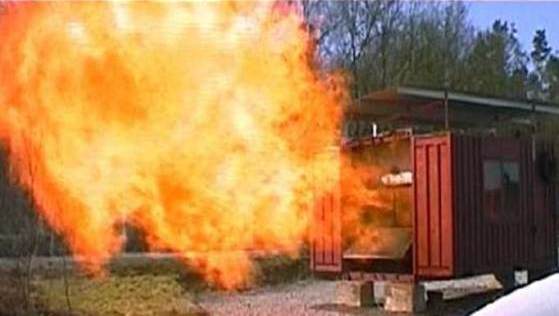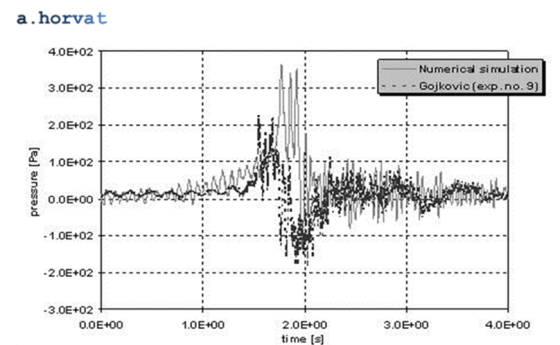Simulation analysis of backdraft development
Backdraft is one of the most hazardous events related to under-ventilated fires. It
is caused by fuel vapour being generated after a fire is extinguished, or
reduced in intensity by oxygen starvation, and the subsequent introduction of fresh
oxygen, for example by opening a door. Following the mixing of fresh air with
the fuel rich environment, concentrations can return to the combustible range,
and since ignition sources are likely to exist, flaming combustion may be initiated
and can develop into a deflagration.

Backdraft experiment [1]
CFD modelling of a full scale backdraft experiment was conducted. The numerical
simulations covered the initial gravity current, the ignition, the spreading of flame in the
enclosure, the external fireball and the subsequent decay.
The Detached Eddy Simulation (DES) approach was used to model turbulence. In order to
describe the combustion process of the mixture from the local ignition to progressive
deflagration, three separate combustion models were implemented for laminar, low and
high intensity turbulence flow regimes.
The calculated ignition time is slightly shorter than the average ignition
time observed in the experiments. The fire front progresses through the combustible
mixture, generating a cloud of hot gases that are accelerated from the container into
the external environment. The velocity increases up to 20 m/s. When the fire front
reaches the door, combustion continues outside the enclosure as the fuel has been pushed
through the door.

Pressure sensor comparison for the backdraft simulation [2]
The comparison between the calculated time history of relative pressure
and the pressure sensor record shows that the numerical simulations slightly overpredict
the flame front speed, with a stronger pressure pulse and higher temperatures than the
observations.
References
- D. Gojkovic, Initial Backdraft Experiments, Report 3121, 2000, Department of Fire Safety Engineering, Lund University, Sweden.
- A. Horvat, Y. Sinai, D. Gojkovic, B. Karlsson, Numerical and Experimental Investigation of Backdraft, Combust. Sci. and Tech., 2008, Vol. 180, pp. 45–63.
Dr Andrei Horvat
M.Sc. Mechanical Eng.
Ph.D. Nuclear Eng.
phone
+44 79 72 17 27 00
skype
a.horvat
e-mail
mail@caspus.co.uk
M.Sc. Mechanical Eng.
Ph.D. Nuclear Eng.
phone
+44 79 72 17 27 00
skype
a.horvat
mail@caspus.co.uk

